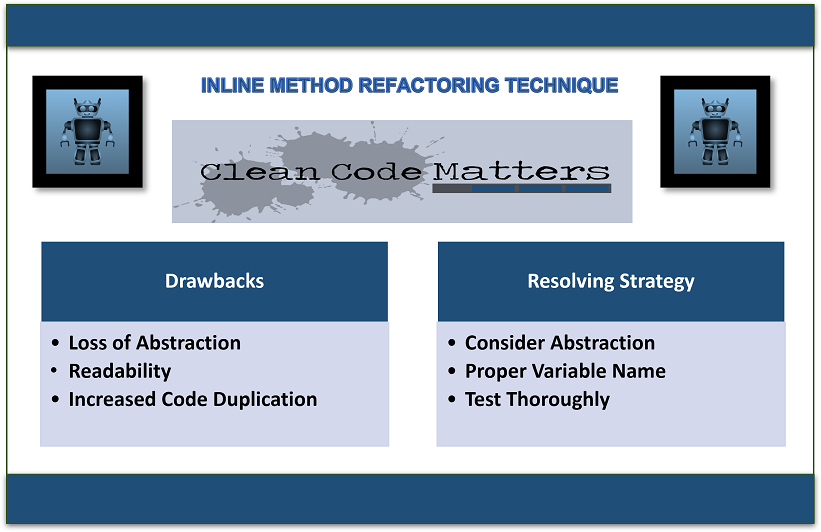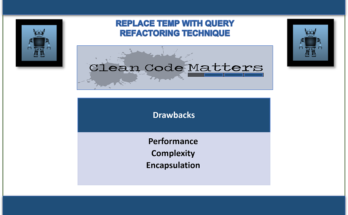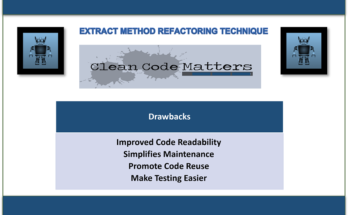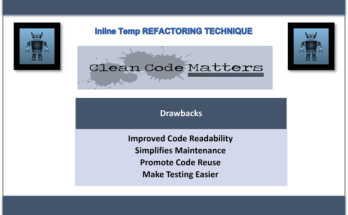Inline method refactoring is a technique used in software development to improve the design and maintainability of code. It involves taking a method call and replacing it with the code from the method itself.
How to Apply the Inline Method Refactoring Technique?
To apply the inline method refactoring technique, follow these steps:
- Find a method that is only used a single time in the code or that merely executes the call site’s instructions.
- Check to see if the method is straightforward enough that its contents may be inlined and still be understood.
- Find all the places in the code where the method is used if it satisfies the aforementioned requirements.
- The method’s contents should be substituted for each call to the method.
- After the method has been inlined, make sure the code still compiles and executes as expected.
- Remove the method from the code after it has been inlined.

Problem
Use this strategy when the method body is more obvious than the method itself.
Before Refactoring
def calculateTotalPrice(price, quantity):
return price * quantity
def calculateFinalPrice(price, quantity, taxRate):
total = calculateTotalPrice(price, quantity)
finalPrice = total + (total * taxRate)
return finalPrice
# Example usage
price = 10.0
quantity = 2
taxRate = 0.08
finalPrice = calculateFinalPrice(price, quantity, taxRate)
print(f"Final price: ${finalPrice:.2f}")
Solution
Remove the method itself and replace any calls with the method’s content.-
After Refactoring
# Inlined calculateTotalPrice method
def calculateFinalPrice(price, quantity, taxRate):
total = price * quantity
finalPrice = total + (total * taxRate)
return finalPrice
# Example usage
price = 10.0
quantity = 2
taxRate = 0.08
finalPrice = calculateFinalPrice(price, quantity, taxRate)
print(f"Final price: ${finalPrice:.2f}")
In this example, the calculateTotalPrice method is only called once in the calculateFinalPrice method, so it can be safely inlined to simplify the code. The resulting code is shorter and easier to read, while still producing the same result.
Drawbacks of the Inline Method Refactoring Technique
Inline method refactoring can, in some circumstances, increase the readability and performance of the code, but it can also have consequences if used excessively or improperly. The following list of typical problems with inlining techniques includes solutions as well:
- Code duplication: If the same code is repeated throughout the codebase as a result of inlining functions, code duplication may result. This may make it more difficult to update and maintain the code.
- Reduced modularity: By making it more difficult to reuse code across various sections of the codebase, inlining methods can reduce code modularity.
- Increased code size: Inlining techniques might make the code larger and more difficult to read and comprehend.
- Resolution: Methods should only be inlined where doing so results in shorter, more understandable, and more maintainable code. It can be preferable to keep the inlined code as a separate function if it is intricate or lengthy.
- Reduced testability: Inlining techniques can make it more difficult to isolate and test certain pieces of code, which can diminish testability.
Resolving Strategy
- To prevent code duplication, it is advisable to maintain a method that is used in several locations as a separate method. Only simple, once-only inline methods make the code easier to read.
- To make a method more modular and reusable, if it is inlined in a way that limits modularity, it can be extracted into a different function or method.
- Method inlining should only be utilized if it does not compromise the code’s testability. If the inlined code has unintended consequences, it can be isolated into a different procedure and checked separately.
You can also visit other blogs to better understand the most recent hot topics in technology.


